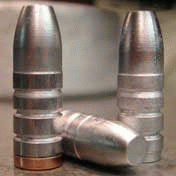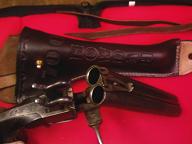

 The Accurate Reloading Forums
The Accurate Reloading Forums  THE ACCURATE RELOADING.COM FORUMS
THE ACCURATE RELOADING.COM FORUMS  Guns, Politics, Gunsmithing & Reloading
Guns, Politics, Gunsmithing & Reloading  Cast Bullets
Cast Bullets  Math guy wanted....?
Math guy wanted....?Go  | New  | Find  | Notify  | Tools  | Reply  |  |
| one of us |
Being post computer crash May 03, course some of the stuff from the old drive took a hike. One of those items was the rough sketch way I used to determine potential bullet wts of cast designs. Figuring new multipliers for different alloys won't be that difficult but I am looking for a user friendly/slick way to figure volume of these PRO-jectiles. Your help and input would be greatly appreciated. Thanks, Jay | ||
|
| one of us |
Of the many ways this could be done, let me toss out a couple of ways. We're looking at methods of figuring VOLUME. Volume can be translated to weight by knowing the denisty of the various alloys. So the problem is to divide the bullet into smaller common shapes that are easy to calculate. There might be 5 or so different forms - cylinders, truncated cones, and the various curved surfaces of the ogives. So, IF the universal software to do this level of math is something like EXCEL, it's just a matter of sitting down and writing a few formulas, punching them into the spreadsheet so for the new design one simply puts into the formulas the diameter and length of each section and add up all the pieces to calculate the total volume. Is easy, no? This could easily be shared as well. The other way, less available to the populus, is to draw the bullet in 3d in CAD and it gives you the volume automatically. | |||
|
| one of us |
Cool. Is the volume or weight easily figured for the HBC? | |||
|
| new member |
And another way is to place the projectile in a graduated beaker of water and see how much water it displaces ( subtract one reading form the other)...usually given in "cc". wrg-inc | |||
|
one of us |
Yeah, but you have to have a projectile in hand to do that. He's wanting to be able to draw a new bullet design and predict its weight, and tailor it to a target specification. | |||
|
| one of us |
EXACTLY. The water method while a good idea isn't precise enough. | |||
|
| one of us |
Aladin, as was previously mentioned, your best bet will be to approximate the volume as a series of geometrical shapes added together. Boolit Body: For example, the boolit body can be considered as a series of stacked disks of various diameters. The formula for the volume of a disk is [pi x radius x radius x hight] Boolit Nose: A pointed nose boolit can be approximated as a cone. This won't be exact, but will be reasonably close. The formula for the volume of a cone is [0.5 x pi x base radius x base radius x hight] A truncated cone's volume can be computed by the same method, except determining the hight of the full cone, and then subtracting the volume for the "missing" portion of the cone. A round nose boolit's volume can be approximated as a half sphere, or [0.5 x pi x radius x radius x radius] Again, these won't be exact volume measurements, but will give you a working estimate of volume. Once you have the volume, you can multiply it times the density of lead, which is 11.3 gm/cc, or 277.9 gr/cubic inch. You're estimating volume and using the density of pure lead, not alloy, so your numbers will be off some. But, you're also estimating the value of pi and you can only measure to within a few ten-thousandths of an inch, so there is considerable error built in before you even begin estimating your boolit weights. Still, if you can get within 5%, I'd say you did a fine job. | |||
|
| one of us |
The water method can be made more precise by using many bullets (10 or so) and dividing the result by that number. We used the water method - taking the (brake pad in this case) tying a thin string around it and lowering it into a container of water. The container had been filled to the absolute limit - so what ever water it spilled was the volume of the brake pad. OK - HBC (as drawn) mass properties follow, followed by mass properties of a 1" cube. (the units you can figrue from there, location of the boolet's axis is on the Z axis, X and Y locations are nearby eachother; one surface of the cube is on the XY plane (Z=0) ). ---------------- SOLIDS ---------------- (c30-210-hbc-trk_Aladin boolet) Mass: 0.0693 Volume: 0.0693 Bounding box: X: 3.6532 -- 4.9032 Y: 6.2065 -- 6.5185 Z: -0.1560 -- 0.1560 Centroid: X: 4.1505 Y: 6.3625 Z: 0.0000 Moments of inertia: X: 2.8055 Y: 1.1999 Z: 4.0047 Products of inertia: XY: 1.8297 YZ: 0.0000 ZX: 0.0000 Radii of gyration: X: 6.3633 Y: 4.1616 Z: 7.6027 Principal moments and X-Y-Z directions about centroid: I: 0.0007 along [1.0000 0.0000 0.0000] J: 0.0064 along [0.0000 1.0000 0.0000] K: 0.0064 along [0.0000 0.0000 1.0000] ---------------- SOLIDS ---------------- (one inch cube) Mass: 1.0000 Volume: 1.0000 Bounding box: X: 3.2165 -- 4.2165 Y: 7.7162 -- 8.7162 Z: 0.0000 -- 1.0000 Centroid: X: 3.7165 Y: 8.2162 Z: 0.5000 Moments of inertia: X: 67.9224 Y: 14.2291 Z: 81.4848 Products of inertia: XY: 30.5355 YZ: 4.1081 ZX: 1.8583 Radii of gyration: X: 8.2415 Y: 3.7722 Z: 9.0269 Principal moments and X-Y-Z directions about centroid: I: 0.1667 along [1.0000 0.0000 0.0000] J: 0.1667 along [0.0000 1.0000 0.0000] K: 0.1667 along [0.0000 0.0000 1.0000] | |||
|
| one of us |
Ya know.. I like that ten bullet idea. Had thought of such but using these electric calculators makes a guy want to hit some 'enter' button.  | |||
|
| One of Us |
Maybe I am missing something about this water method. Can you straighten me out? If I have 10 new bullets in me hand, why not just weigh them on a powder scale instead of dumping them in water? H. C. | |||
|
| one of us |
C'mon Henry.. that'd be too easy... We're looking for ways to figure volume and cross compare to other designs too. But ya know, your scale idea has some merit. | |||
|
| one of us |
HenryC - Weighing them will give you the weight of the bullets as cast. The water method is weighing the WATER that has the same volume as 1 (or 10) bullets. From that you can calculate the volume of the bullets themselves. From that (if you know the DENSITY (weight/unit volume) of lead and/or your bullet alloy you can PREDICT the weight of a bulled design before you make the mould. | |||
|
| one of us |
I seem to be missing something here. If you already have the mold and the boolits, why would you want to predict the weight? | |||
|
| one of us |
What other season than the dead of winter would we be weighing bullets in water and figuring bullet volume with a scale...? Did I get that right?? Gimme that 'enter' button... Cabin fever remedy tomorrow-- shooten no matter the snow flakes et al. Supposed to be 29 tomorrow... I don't care. Send the dog if I'm not home after dark... | |||
|
| one of us |
I you put a dab of detergent in the water it will lower the surface tension of the water and make a more accurate test. Ed Barrett | |||
|
| one of us |
It's cold here, and I don't want to get my hands wet. Since I know that the density of of lead is 277.9 grains per cubic inch, I can use nice dry pencil and paper to figure the volume of any of my boolits to within a couple decimal places. (277.9 gr) / 1.0 cu in = (my boolit weight) / x, or, the volume of my boolit in cu in, X= (1.0 x (my boolit weight)) / 277.9 And I have dry, warm fingers, and no mess to clean up. | |||
|
| one of us |
I just happened to think that maybe y'all like playing with water. So, here's an easier way to find the volume of your boolit. Put a piece of plastic wrap (Saran Wrap, or similar) between the mold halves with the top edge of the wrap even with the top of the cavity (-ies). Hold the halves together tightly and trickle some water into the cavities. If your mold is a good one, only the cavity will fill, and you can then pour the water into the pan of your scale to weigh it. | |||
|
| one of us |
"Since I know that the density of of lead is 277.9 grains per cubic inch" The 45/70 bullet sitting on my computer is one inch long and weighs 411 grs. I think that 277.9 grs is lite? Course I'm the math dropout... maybe that's why | |||
|
| one of us |
Did I screw up a decimal point? Must be. Try 2779.0 grains per cubic inch. My conversion program says that 11.34 grams/ cc is 0.0397 lbs/per cu in, and that times 7000 grains/lb is where I got the conversion factor. | |||
|
| one of us |
There are (at least) two 'math problems' being mixed here. One: from a design that has not been made, calculate the weight (by calculating the volume and using the mass of known alloy or pure lead). Two: from an exising bullet and alloy of known density determine the volume of the bullet. (by using the water method). Regarding the solution of the first, anyone remember the formula for the volume of a truncated cone? I think I'm goin' to clean off the back poarch.... | |||
|
one of us |
The water thing is good for calculateing the density of your alloy. Weigh the boolit first, then see how much water it displaces to get density. | |||
|
| one of us |
Quote: Ok-- that works. Now imagine... what Lars 12 guage slug will weigh using 1.75" OAL... I'd want to mount the thing on a turret, pick up truck bed most likely. And then have some kinda ballist system for the shock  | |||
|
| new member |
Ok, turn the design out on a lathe from brass or al then you can use the water displacement method to predict its weigh in any alloy. From the "model" your can make a cherry or a drawing. wrg-inc | |||
|
| <Guest> |
If you already have it in AutoCAD; a bullet being a simple solid of rotation, won't ACAD give you the volume with one mouse click? Resp'y, Bob S. | ||
|
| one of us |
Bob S. - Yes, exactly right; and that's what I posted in the 8th posting in this thread. The command is massprop (mass properties). Of course one has to specifiy the density of the material, which I had left as the original setting, not knowing at the time, hence the usefull number of the collection was the volume. But not all of us have access to A'CAD or the time to generate the 3d model. Hence the 'need' for other methods of caclulating (or estimating) the weight of a yet-to-be-built design. I've got a spread-sheet about half worked up that with a little work will give approximate volumes, and then approximate weights. | |||
|
| one of us |
OK Guys- Here is a down and dirty way to figure bullet weight off the computer. Draw bullet as polyline to scale in model space and find its area (Computer area of 0.002166667 sq. ft. x 144 sq.-in/sq.ft.= 0.312sq.-in.) . Transform area to a rectangle of bullet diameter by length figured .312" x 1" = 0.312 sq.-in.). Example: rectagle of 1" x .312" = Area of .312 sq.-in. Now convert to volume V=Pi(3.142) x r x r x height. Ex. 3.142 x .312"/2 x .312"/2 x 1"= 0.0764538 cubic inches. Specific Gravity of lead alloys ( 20:1=11.00, 10:1=10.50, Pure=11.34 ) Lets pick 11.00. Now water weighs 62.4lb/cf. Multiply 62.4 x 11.00=686.4 lb/cf / 1,728 cubic in/cubic ft. x 7000 gr./lb = 2780.55 gr./cubic-inch. Multiply the calculated cubic inch (0.0764538) x 2780.55 gr./ cubic-inch = 212.58 gr. bullet weight. Not exactly a clean method, but it works pretty well. All you have to decide is the specific gravity or density of your alloy. | |||
|
| Powered by Social Strata |
| Please Wait. Your request is being processed... |
|

Visit our on-line store for AR Memorabilia

